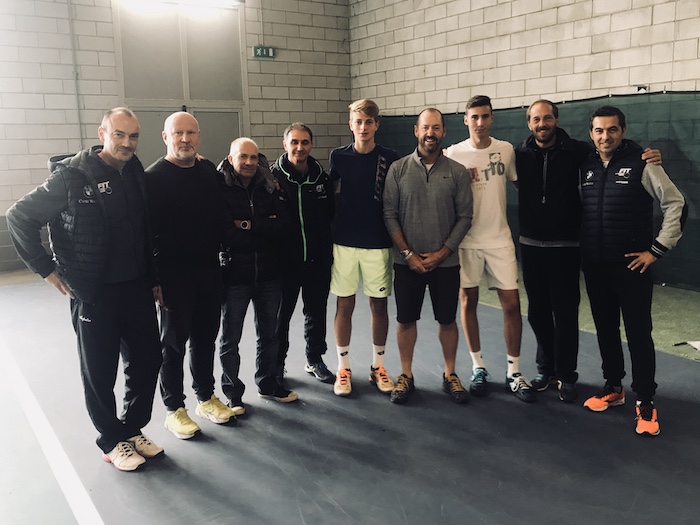G’day,
Steve Tignor just wrote an excellent piece at Tennis.com about Italian tennis. Specifically, it was about the sudden influx of great male players doing so well at the Roland Garros.
I have been consulting with the Italian Tennis Federation since 2016 and have had a first-hand look as to why this is happening. Firstly, click the link below to read the article.
LINK: Why Is Italy Suddenly Producing So Many Good Male Players?
The gentleman in the middle of the picture below is Michelangelo Dell’edera. He is the head of High Performance for Italian tennis and the real mastermind behind the renaissance we are now seeing in the men’s game. The gentleman to the right is Donato Campognoli, who is a technical consultant with the Federation and was instrumental in bringing me to Italy to consult with the Federation.
October 24, 2019: ITF World Conference: Bangkok
Craig O’Shannessy, Michelangelo Dell’edera, Donato Campognoli

The Italian Federation is extremely forward-thinking.
When I first arrived in Rome in May 2016, Michelangelo explained a fundamental philosophy that would prove to be a masterstroke. He looked at all the different components that are needed to create a successful player on the professional tour. He especially looked at what was needed at the junior level to provide the foundations to help them succeed at the pro level. Elements such as technique, fitness, strength, nutrition, training blocks, schedule and match analytics (my specialty) were all identified as keys to success.
Then they did something that very few national bodies would do…
The Italian Federation looked outside of its own ecosystem to find the best people in the world in each specialty and brought them into the fold as consultants. No ego. No jealously. No road blocks. Get the best of the best and learn from them.
In 2018 I traveled to the High-Performance junior academies around the country presenting new match metrics to the coaches. The goal was to identify what matters most to winning matches at a junior and pro-level, and structure the practices accordingly. Needless to say, a major focus was on the first four shots of the point.
Below is an Instagram post from 2018 showing where I traveled with Italian coach, Giovanni Paolisso.
I remember Michelangelo introducing me to a room full of coaches when I visited Bari in the south. I stood next to him at the front of the room as he started by telling a story about the five different revolutions that have occurred in the modern game.
Revolution 1 = Bjorn Borg.
He said that nobody had played our game with so much spin as Borg did. He also talked about how Borg showed no negative emotions on the court. Borg certainly took these two elements of his game to a whole new level.
Revolution 2 = Ivan Lendl
The focus here was hard work. Lendl was not the most gifted with natural talent but nobody worked harder on their game to improve it than Lendl did. He was the poster child for reaching the pinnacle of our game through hard work and determination.
Revolution 3 = Nick Bollettieri
Nick changed the practice court. He was the first person to create a true “academy” where players came to live and train with each other. Nick was also the ultimate motivator.
Revolution 4 = Equipment
Wooden rackets are gone. White balls are gone. The equipment has drastically changed over the last few decades. Space-age materials have found their into tennis rackets. The ball explodes off the racket with massive spin thanks to new string technology.
Revolution 5 = The Person Standing Next To Me
This was quite a shock for me. I had been listening intently to the first four revolutions and was eager to hear what the fifth one was. He told the Italian coaches. “The fifth revolution in our sport is standing right next to me,” Michelangelo said smiling at me. All the coaches in the room diverted their attention from Michelangelo to me, and I must admit it was very humbling. Michelangelo talked about how match analytics will be the wave of the future that will help us better understand what happens in matches. It will re-shape our practice court. Michelangelo told the coaches that I have been brought to Italy to teach Italian coaches what really matters to winning and losing, and we are “all in” with this guy. “Whatever he tells us to do, we are doing it.”
Now you get an idea why Italian tennis is flourishing so much at the moment. It’s an attitude. It’s a belief system. It’s rooted in facts. It’s driven by video and analysis. Below are some pictures from my many trips to Italy in the last six years.
Best,
Craig










































